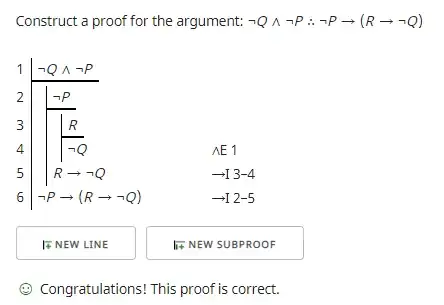I have a quick question regarding the introduction rule for the conditional: do you always need to proceed from an assumption or could you start from a premise? If so, then how would you go about it?
I need to prove the following formula using natural deduction: ¬Q ∧ ¬P ˫ ¬P → (R → ¬Q)
I've also made a quick proof.
1 (1) ¬Q ∧ ¬P P 2 (2) ¬P A 3 (3) R A 1 (4) ¬Q 1∧E 1 (5) R → ¬Q 1,3 →I 1 (6) ¬P → (R →¬Q) 2, 5 →I
I'm just wondering whether I have to assume ¬P in (2), when I already have it in (1)? Would it mean that ¬P is perfectly superfluous for the argument? That would seem to follow from the paradoxes of material implication (e.g B ˫ A → B).

